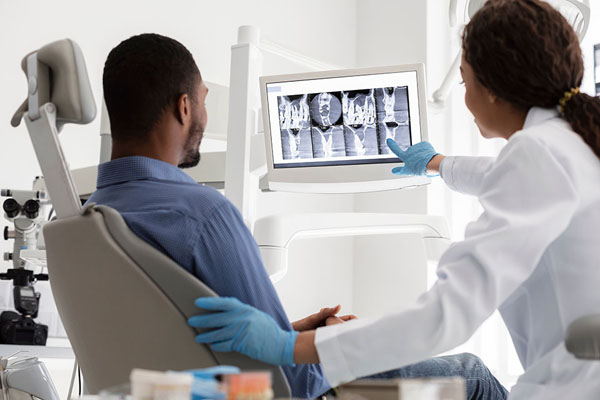How Temporomandibular Joint Disorders Develop
Temporomandibular joint disorder, or TMD, is a common condition that affects the jaw joints and muscles. While the exact causes of TMD aren’t always clear, several risk factors and preventive measures can help reduce the risk of developing this condition.
If you’re experiencing temporomandibular joint disorder symptoms, contact our Sacramento dental practice today by calling (916) 929-9222 to set up a TMJ consultation.
Common Causes of TMJ Disorders
There are various causes of TMJ disorders. Some of the most common causes of temporomandibular disorders include:
- Traumatic Injuries: Trauma to the jaw or face, such as a blow or whiplash, can damage the jaw joint and surrounding muscles and cause TMJ disorders.
- Teeth Grinding or Clenching: Bruxism, the habit of grinding or clenching the upper and lower teeth, can put excessive pressure on the jaw joint and lead to TMJ disorders.
- Arthritis: Arthritis, particularly osteoarthritis and rheumatoid arthritis, can damage the jaw joint and lead to TMJ disorders.
- Stress: Chronic stress can cause tension and tightness in the jaw muscles and the face.
- Dental Problems: Dental conditions such as misaligned teeth, overbites, and underbites can stress the jaw joint and lead to TMJ disorders.
- Joint Degeneration: Over time, the cartilage in the jaw joint can degenerate, leading to TMJ disorders.
- Muscle Dysfunction: Dysfunction or imbalance of the muscles responsible for jaw movement and control can contribute to TMD. This may include overuse or strain of these muscles.
- Lifestyle Factors: Smoking and excessive alcohol consumption may be associated with an increased risk of TMD.
Risk Factors for TMJ Disorders
Common TMD risk factors include:
- Gender: Women are more likely to develop TMJ disorders than men, possibly due to hormonal differences and increased prevalence of conditions such as fibromyalgia and chronic fatigue syndrome.
- Sleep Disorders: Conditions like sleep apnea and snoring can disrupt sleep patterns and lead to jaw clenching or bruxism during sleep, increasing the risk of TMJ disorders.
- Age: TMJ disorders are most common in individuals between the ages of 20 and 40, although they can develop at any age.
- Genetics: There may be a genetic component to TMJ disorders, as some individuals may inherit a predisposition to this condition.
- Poor Posture: Poor posture can strain the muscles of the neck and jaw, leading to TMJ disorders.
When It’s Time to See the Doctor
If you’re at risk for developing a TMJ disorder and regularly experience symptoms, you should consult with a healthcare professional for an accurate diagnosis and appropriate treatment plan.
Symptoms that may indicate it’s time to see the doctor, include:
- Persistent Jaw Pain: If you’re experiencing persistent pain in the jaw, face, or ears, it may be a sign of a temporomandibular joint disorder. Severe pain that interferes with daily activities or doesn’t improve with self-care measures should prompt a visit to the doctor.
- Limited Jaw Movement: If you’re having difficulty opening or closing your mouth, or if your jaw feels stiff or locked, it may be a sign of a TMJ disorder.
- Clicking or Popping Sounds: If you hear clicking, popping, or grinding sounds when you open or close your mouth, it may indicate a TMJ disorder. While some people may experience these sounds without any associated pain or discomfort, they can also be a sign of joint dysfunction.
- Changes in Bite: If your bite feels off or your teeth don’t seem to fit together, it may point to TMD.
- Headaches: Headaches, particularly those in the temples or around the eyes, can indicate temporomandibular joint disorders.
Frequently Asked Questions
Can TMJ disorders be prevented?
Yes, there are some steps you can take to prevent TMD. While TMJ disorders cannot always be prevented, several preventive measures can reduce the risk of developing this condition. These include practicing good oral hygiene, avoiding hard and chewy foods, managing stress, and maintaining good posture.
Who is most likely to get a TMJ disorder?
Anyone can develop a TMJ disorder, but women between the ages of 18 to 44 are more likely to experience this condition. Additionally, those with a history of arthritis or other joint problems may be at a higher risk of developing TMJ. Consult your doctor if you believe you have the beginning symptoms of TMD.
Does TMJ develop suddenly?
It depends. TMJ can develop suddenly, but it can also develop gradually over time. Some people may experience mild symptoms that worsen over time, while others may experience a sudden onset of severe symptoms.
What does the beginning of TMJ feel like?
The beginning of TMJ can feel like tenderness or pain in the jaw, particularly when chewing or speaking. Some people may have facial pain and also experience a clicking or popping sound when moving their jaw. As TMJ progresses, the pain may become more severe, and other symptoms, such as headaches and ear pain may also develop.
Determine the Root Cause of TMD and Seek Treatment
If you’re experiencing symptoms of TMD, such as pain or tenderness in the jaw, difficulty opening or closing the mouth, or clicking or popping sounds when moving the jaw, consult Dr. Name. They can provide an accurate diagnosis and recommend an appropriate treatment plan to help alleviate your symptoms and improve your quality of life.
Call our dentist in Sacramento at (916) 929-9222 to schedule a consultation today.


